Abstract
Between 1970 and 1979 acute lymphoblastic leukaemia was diagnosed in 378 children at this hospital. The outcome for the 181 survivors was examined six or more years after diagnosis to assess morbidity in an unselected group of long term survivors. One hundred and thirty seven of the survivors were in first remission and probably cured (group I). Forty four (group II) had had one or more relapses, some of whom, who had isolated extramedullary relapses, also have a good chance of cure.
In group I 136 patients had prophylactic cranial or craniospinal irradiation, while patients in group II, in addition to having that treatment, received local testicular (17) or craniospinal radiation (seven) for testicular or central nervous system relapse. Eight had additional prophylactic cranial radiotherapy after bone marrow relapse, and six had total body irradiation before bone marrow transplantation. The incidence of clinically important growth and endocrine morbidity was 20% in group I and 68% in group II. The morbidity in patients in group I was mainly attributable to early pubertal maturation. In group II 30 patients had growth failure, of whom 19 had gonadal failure from testicular or total body irradiation, 14 had growth hormone deficiency after doses of cranial irradiation of over 2400 cGy, and 10 had spinal growth impairment after craniospinal irradiation. Two also had early pubertal maturation. Five out of six patients who received total body irradiation had multiple endocrine deficiency. Neuropsychological sequelae of treatment were seen in 40 (42%) of 96 schoolchildren in group I and in 12 (38%) of 32 schoolchildren in group II. Postinfective sequelae of treatment were found in patients in both groups.
These results show that the survivors who were in their first remission had a 42% residual morbidity related to treatment compared with an 82% morbidity in the survivors of one or more relapses who had multiple treatments.
Full text
PDF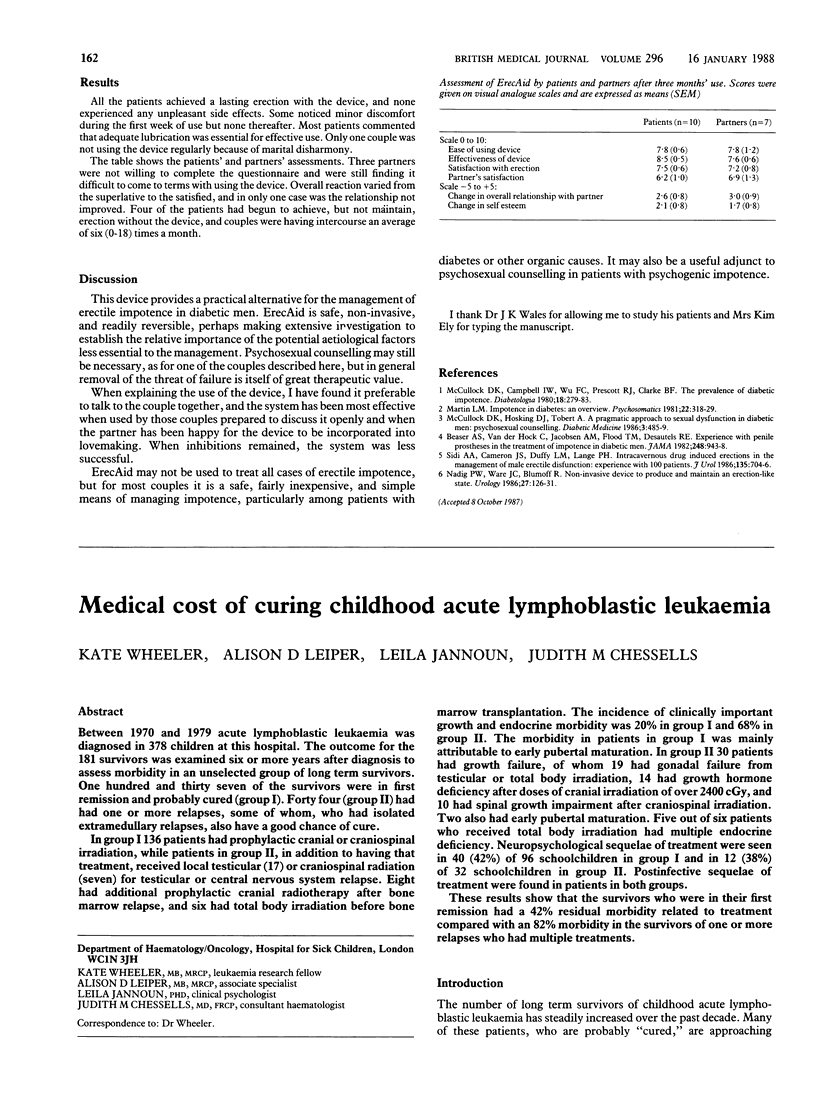
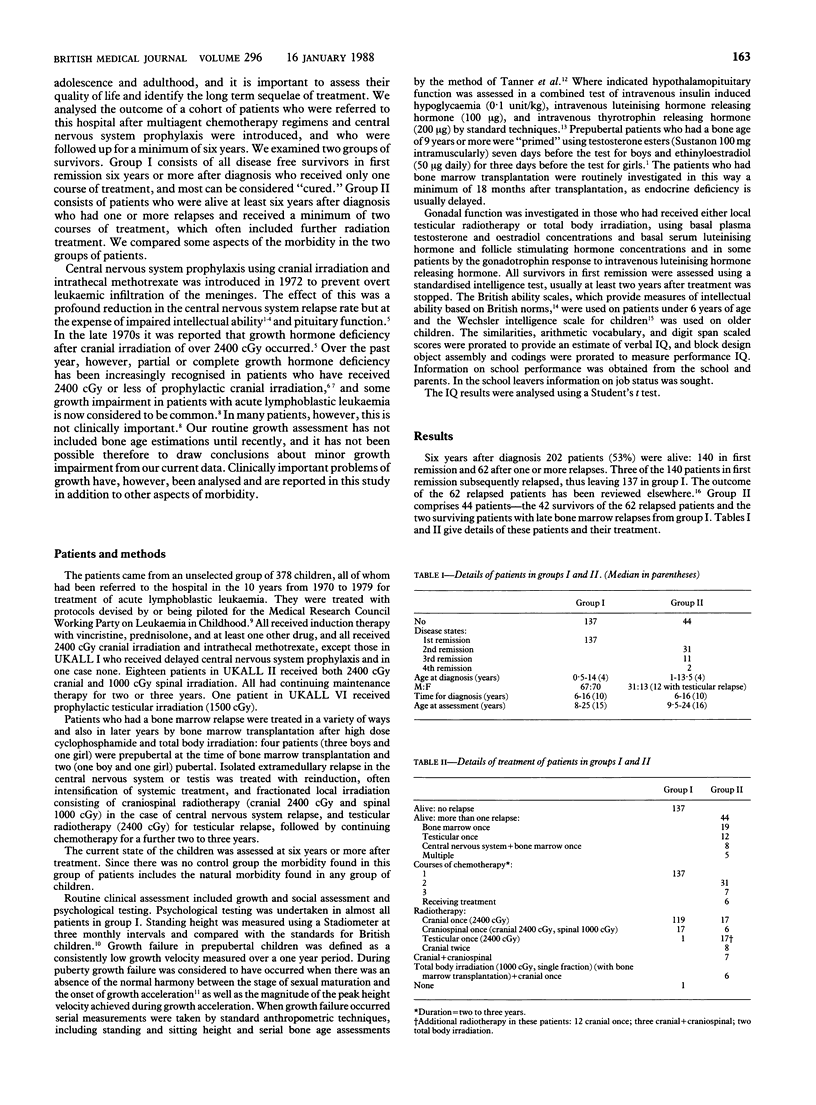
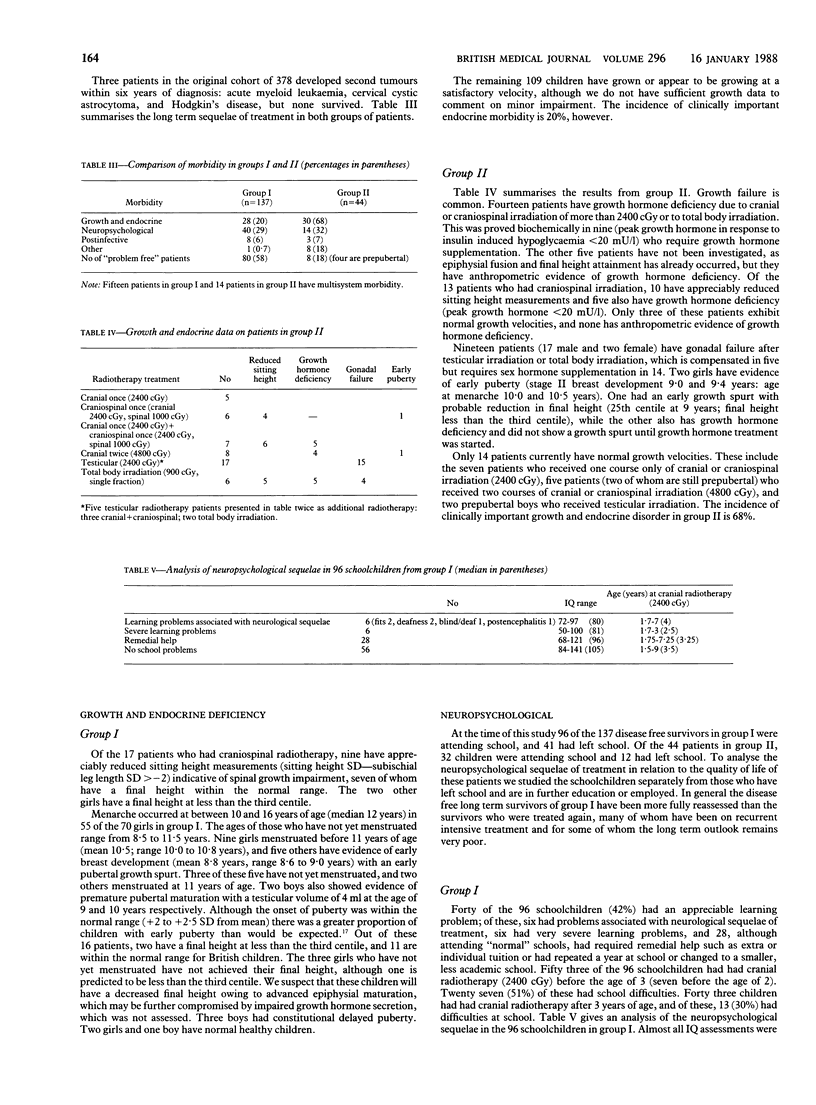
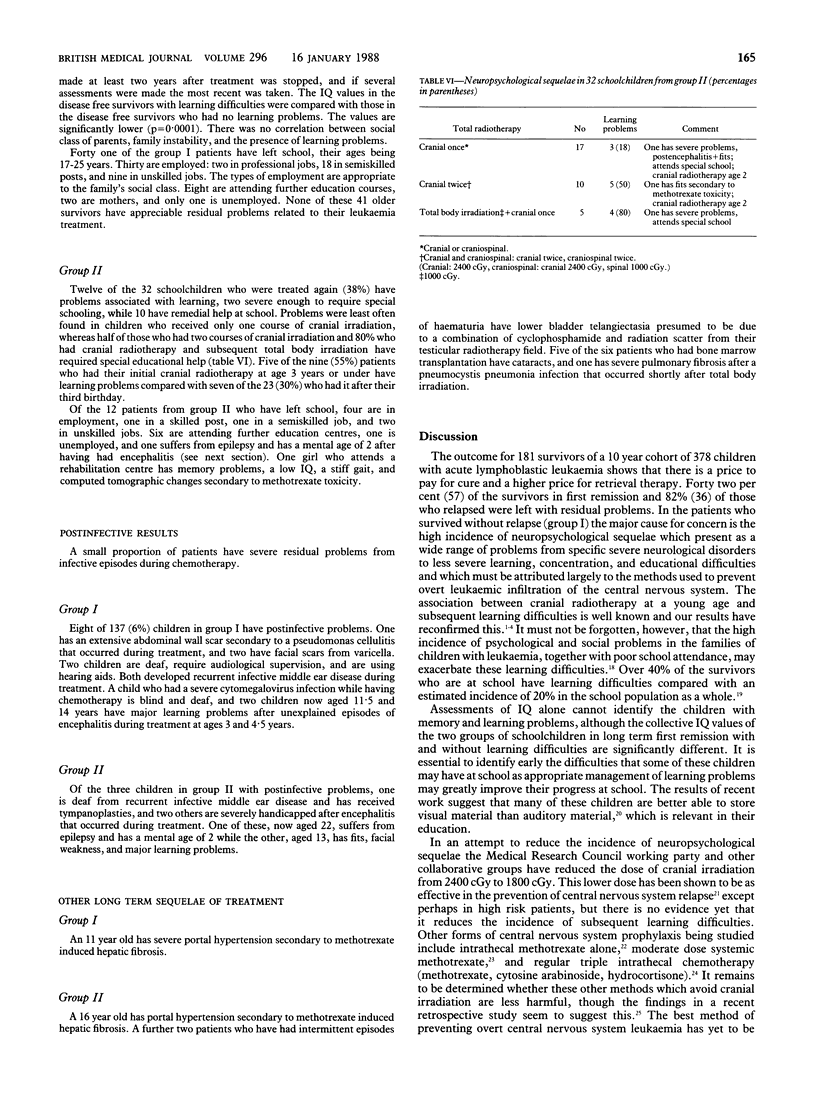
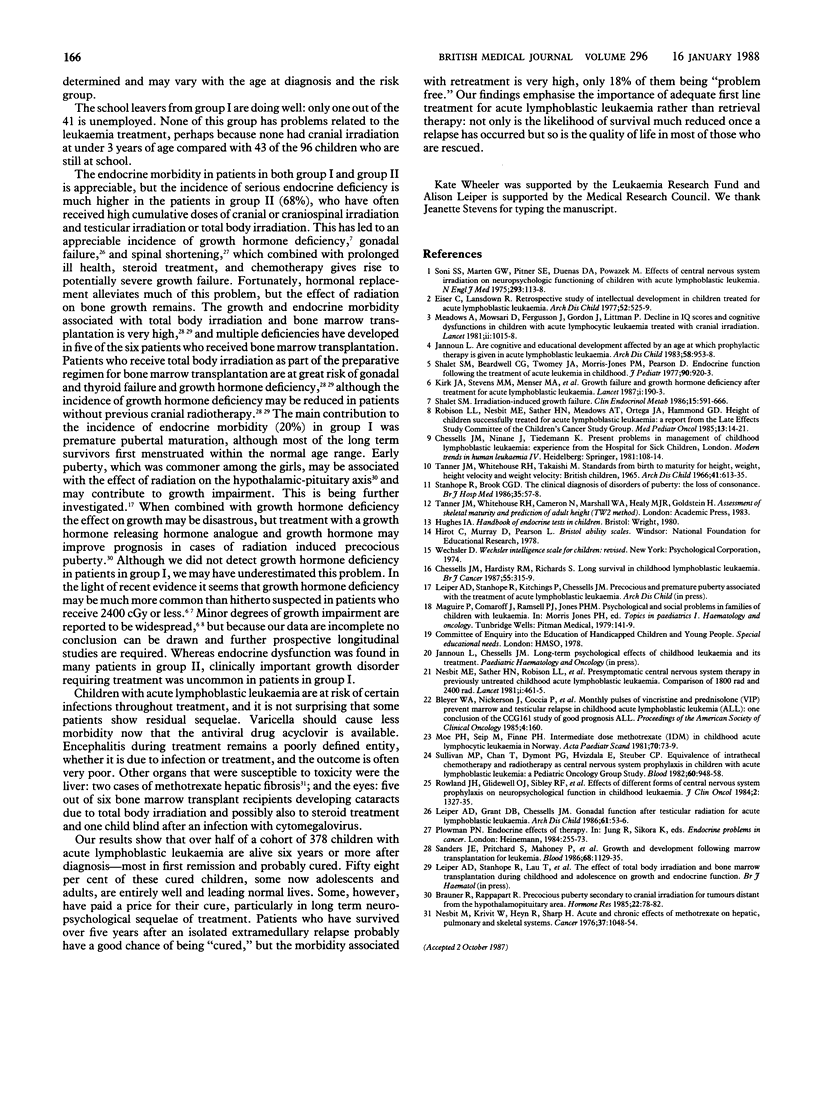
Selected References
These references are in PubMed. This may not be the complete list of references from this article.
- Brauner R., Rappaport R. Precocious puberty secondary to cranial irradiation for tumors distant from the hypothalamo-pituitary area. Horm Res. 1985;22(1-2):78–82. doi: 10.1159/000180076. [DOI] [PubMed] [Google Scholar]
- Chessells J. M., Hardisty R. M., Richards S. Long survival in childhood lymphoblastic leukaemia. Br J Cancer. 1987 Mar;55(3):315–319. doi: 10.1038/bjc.1987.62. [DOI] [PMC free article] [PubMed] [Google Scholar]
- Chessells J. M., Ninane J., Tiedemann K. Present problems in management of childhood lymphoblastic leukaemia: experience from the Hospital for Sick Children, London. Haematol Blood Transfus. 1981;26:108–114. doi: 10.1007/978-3-642-67984-1_16. [DOI] [PubMed] [Google Scholar]
- Eiser C., Lansdown R. Retrospective study of intellectual development in children treated for acute lymphoblastic leukaemia. Arch Dis Child. 1977 Jul;52(7):525–529. doi: 10.1136/adc.52.7.525. [DOI] [PMC free article] [PubMed] [Google Scholar]
- Jannoun L. Are cognitive and educational development affected by age at which prophylactic therapy is given in acute lymphoblastic leukaemia? Arch Dis Child. 1983 Dec;58(12):953–958. doi: 10.1136/adc.58.12.953. [DOI] [PMC free article] [PubMed] [Google Scholar]
- Kirk J. A., Raghupathy P., Stevens M. M., Cowell C. T., Menser M. A., Bergin M., Tink A., Vines R. H., Silink M. Growth failure and growth-hormone deficiency after treatment for acute lymphoblastic leukaemia. Lancet. 1987 Jan 24;1(8526):190–193. doi: 10.1016/s0140-6736(87)90004-3. [DOI] [PubMed] [Google Scholar]
- Leiper A. D., Grant D. B., Chessells J. M. Gonadal function after testicular radiation for acute lymphoblastic leukaemia. Arch Dis Child. 1986 Jan;61(1):53–56. doi: 10.1136/adc.61.1.53. [DOI] [PMC free article] [PubMed] [Google Scholar]
- Meadows A. T., Gordon J., Massari D. J., Littman P., Fergusson J., Moss K. Declines in IQ scores and cognitive dysfunctions in children with acute lymphocytic leukaemia treated with cranial irradiation. Lancet. 1981 Nov 7;2(8254):1015–1018. doi: 10.1016/s0140-6736(81)91216-2. [DOI] [PubMed] [Google Scholar]
- Moe P. J., Seip M., Finne P. H. Intermediate dose methotrexate (IDM) in childhood acute lymphocytic leukemia in Norway. Preliminary results of a national treatment program. Acta Paediatr Scand. 1981 Jan;70(1):73–79. doi: 10.1111/j.1651-2227.1981.tb07176.x. [DOI] [PubMed] [Google Scholar]
- Nesbit M. E., Jr, Sather H. N., Robison L. L., Ortega J., Littman P. S., D'Angio G. J., Hammond G. D. Presymptomatic central nervous system therapy in previously untreated childhood acute lymphoblastic leukaemia: comparison of 1800 rad and 2400 rad. A report for Children's Cancer Study Group. Lancet. 1981 Feb 28;1(8218):461–466. doi: 10.1016/s0140-6736(81)91849-3. [DOI] [PubMed] [Google Scholar]
- Nesbit M., Krivit W., Heyn R., Sharp H. Acute and chronic effects of methotrexate on hepatic, pulmonary, and skeletal systems. Cancer. 1976 Feb;37(2 Suppl):1048–1057. doi: 10.1002/1097-0142(197602)37:2+<1048::aid-cncr2820370811>3.0.co;2-v. [DOI] [PubMed] [Google Scholar]
- Robison L. L., Nesbit M. E., Jr, Sather H. N., Meadows A. T., Ortega J. A., Hammond G. D. Height of children successfully treated for acute lymphoblastic leukemia: a report from the Late Effects Study Committee of Childrens Cancer Study Group. Med Pediatr Oncol. 1985;13(1):14–21. doi: 10.1002/mpo.2950130105. [DOI] [PubMed] [Google Scholar]
- Rowland J. H., Glidewell O. J., Sibley R. F., Holland J. C., Tull R., Berman A., Brecher M. L., Harris M., Glicksman A. S., Forman E. Effects of different forms of central nervous system prophylaxis on neuropsychologic function in childhood leukemia. J Clin Oncol. 1984 Dec;2(12):1327–1335. doi: 10.1200/JCO.1984.2.12.1327. [DOI] [PubMed] [Google Scholar]
- Sanders J. E., Pritchard S., Mahoney P., Amos D., Buckner C. D., Witherspoon R. P., Deeg H. J., Doney K. C., Sullivan K. M., Appelbaum F. R. Growth and development following marrow transplantation for leukemia. Blood. 1986 Nov;68(5):1129–1135. [PubMed] [Google Scholar]
- Shalet S. M., Beardwell C. G., Twomey J. A., Jones P. H., Pearson D. Endocrine function following the treatment of acute leukemia in childhood. J Pediatr. 1977 Jun;90(6):920–923. doi: 10.1016/s0022-3476(77)80559-3. [DOI] [PubMed] [Google Scholar]
- Shalet S. M. Irradiation-induced growth failure. Clin Endocrinol Metab. 1986 Aug;15(3):591–606. doi: 10.1016/s0300-595x(86)80011-1. [DOI] [PubMed] [Google Scholar]
- Soni S. S., Marten G. W., Pitner S. E., Duenas D. A., Powazek M. Effects of central-nervous-system irradiation on neuropsychologic functioning of children with acute lymphocytic leukemia. N Engl J Med. 1975 Jul 17;293(3):113–118. doi: 10.1056/NEJM197507172930303. [DOI] [PubMed] [Google Scholar]
- Stanhope R., Brook C. G. Clinical diagnosis of disorders of puberty. Br J Hosp Med. 1986 Jan;35(1):57–58. [PubMed] [Google Scholar]
- Sullivan M. P., Chen T., Dyment P. G., Hvizdala E., Steuber C. P. Equivalence of intrathecal chemotherapy and radiotherapy as central nervous system prophylaxis in children with acute lymphatic leukemia: a pediatric oncology group study. Blood. 1982 Oct;60(4):948–958. [PubMed] [Google Scholar]
- Tanner J. M., Whitehouse R. H., Takaishi M. Standards from birth to maturity for height, weight, height velocity, and weight velocity: British children, 1965. II. Arch Dis Child. 1966 Dec;41(220):613–635. doi: 10.1136/adc.41.220.613. [DOI] [PMC free article] [PubMed] [Google Scholar]


